-1.jpg)
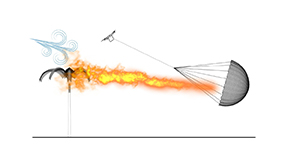
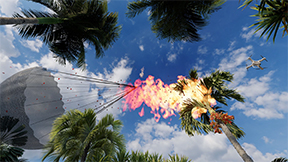
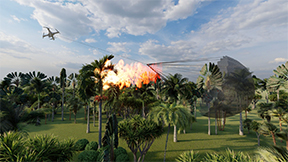
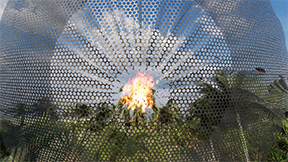
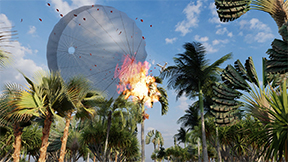
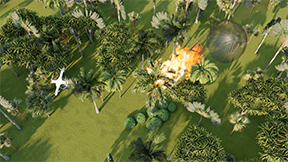

-9.jpg)
-10.jpg)
-11.jpg)
-12.jpg)
-13.jpg)
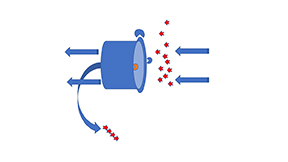
-15.jpg)
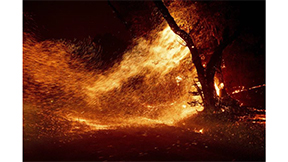
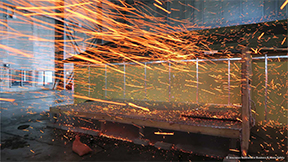
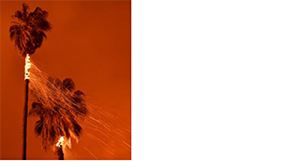
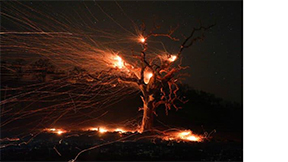
-20.jpg)
-21.jpg)
PROVISIONAL PATENT APPLICATION
of
Bradley Lawrence Bartz
for
AIRBORNE FIRE NETTING SYSTEM FOR WILDFIRE SUPPRESSION
Client /Matter No. 215-006
Sheets of Drawing Figures: [QTY]
PTO Customer No. 47533
INTELLECTUAL PROPERTY LAW OFFICES OF JOEL VOELZKE, APC
24772 W. Saddle Peak Road
Malibu, California 90265-3042
Telephone: (310) 317-4466
AIRBORNE FIRE NETTING SYSTEM FOR WILDFFIRE SUPPRESSION
CROSS-REFERENCE TO RELATED APPLICATIONS
[0001] None.
BACKGROUND OF THE INVENTION
1. FIELD OF THE INVENTION:
[0002] This invention relates to the field of fire fighting systems. More particularly, this invention relates to the field of an airborne fire netting system for wildfire suppression and containment.
2. DESCRIPTION OF RELATED ART
[0003] Every year wildfires do enormous damage throughout the world. Some wildfires in recent years have killed dozens of people, burned hundreds and even thousands of homes and other structures, and inflicted billions of dollars in damage. Wildfires such as the 2017 Paradise fire in Northern California and the 2018 Woolsey fire in Southern California are regularly driven by strong dry winds. Wildfires driven by winds of 40 mph or stronger they are nearly impossible to stop, in part because burning embers particularly from trees can fly hundreds of yards, and sometimes even miles, allowing the fire to quickly hopscotch from one location to multiple new location creating new ignition points far away. Palm trees in particular have been identified as constituting "fire bombs" that shed burning large burning palm fronds from high in the air that often float for long distances before they finally land. Many climate experts predict that the losses of life and property due to wildfires will increase as average temperatures increase due to climate change. Accordingly there exists a need for improved methods of suppressing wildfires.
SUMMARY OF THE INVENTION
[0004] The present invention is of fire containment system that employs an airborne fire netting to capture flying embers, particularly from trees that constitute "fire bombs," as those embers begin flying, to prevent those embers from either travelling far or from hitting fresh fuel-containing ground before they land. By capturing and containing flying embers as those embers are launched, the invention is expected to significantly slow the spread of wildfire, thus aiding other firefighting efforts and buying valuable time for people in the path of the fire to evacuate and/or otherwise prepare for the fire. The netting may be carried and held aloft by one or more unmanned aerial vehicles (UAVs) commonly referred to as drones.
[0005] Drones typically use battery power, and accordingly their ability to remain powered in flight is unaffected by smoke and fire which could choke a UAV or manned aircraft powered by an internal combustion engine (ICE). Battery-powered drones are now available that have lift capacities of nearly 2,000 lbs. Suppliers of battery operated, high lift capacity drones include Griff Aviation of Norway, www.griffaviation.com. The present invention leverages the ability of battery operated high lift capacity drones to rapidly carry fire nettings and deploy and hold them over hard to access, rugged terrain in wildfire environments.
[0006] Additionally, drones typically include video cameras to allow them to be remotely operated, as well as automatic "return to base" capability if communication with the base station controller gets interrupted. Preferably the drones of the present intention are also equipped with thermal sensing and imaging and the ability through artificial intelligence (AI), pattern recognition, or other programming to autonomously identify and target ember sources such as burning trees. Further, drones can be programmed to operate as a group, and/or to avoid each other while independently carrying out similar tasks. Drones operating in a group are sometimes referred to as swarm drones.
[0007] The fire netting is preferably of a strong, lightweight, fire resistant material such as Kevlar® or similar material. The mesh of the net is tight enough to contain dangerous flying embers, yet loose enough to allow wind to flow through sufficiently so that the fire netting can be carried and held in a strong wind by a drone. The material may be multi-layered interspersed netting in order to maximize its ability to catch and stop embers yet allow wind to flow through with a minimum of wind resistance.
[0008] In one embodiment the fire netting when deployed has the shape of a round parachute. It may be tethered to a single UAV by a single cord made of fire resistant material.
[0009] In another embodiment the fire netting has a generally square or rectangular shape, and is carried by two drones, one at each top corner. The bottom corners may be weighted for ballast, and/or carried by two additional drones. The four drones operating together carry the netting to a target location and cooperate together to hold the netting at an optimum shape and location to catch embers from the target ember source. The netting may be initially rolled into a roll, and then when the drones reach their target they unfurl the netting.
[0010] In another embodiment suitable for stationary operation the netting is held aloft by one or more lifting kites. Many different kite designs have been used as lifting kites. One type known as a "French Military Kite" or "Rescue Kite" is a triangular winged box kite similar to a classic box kite but having only three sides to the box instead of four, and having has dihedral wings added to one surface which increases its side to side stability. this type of kite and is favored by some due to its ability to lift payloads such as antennas in a wide variety of conditions.
[0011] The kites may be accurately positioned in the sky via one or more drones that are attached directly to, or otherwise tethered to, the kites. In this embodiment because the weight of the netting is borne by the kite(s) instead of the drones, the flying time of the drones is greatly increased.
[0012] The drones may carry a small supply of water or other fire suppressant material such as PhosCheck®, and may direct a spray of that material from the drones to embers that have been caught in the netting.
[0013] In another embodiment suitable for stationary operation the drones are tethered to the ground. When tethered, drones can be supplied with electrical power from the ground allowing them to stay aloft as long as needed. Tethered drones can also be supplied with water or other fire suppressant material such as PhosChek® from the ground via a tube or hose, and can direct a spray of that material onto the embers that have been caught by the netting. Alternatively, the drones may carry an onboard supply of wire or other fire suppressant liquid or material, and can spray the fire suppressant onto burning embers within the net.
[0014] In another embodiment one or more drones carries a netting and positions it over a tree such as a palm tree, either before or after the tree has caught fire, and releases the netting thereby encapsulating the tree and thus significantly reducing the large burning embers that will be shed from it.
[0015] In another embodiment the fire netting is integrated into the construction of one or more lifting kites thereby defining a large, self-lifting fire net. The self-lifting fire net may be accurately positioned by one or more drones.
[0016] In one aspect the invention is of a fire netting made of a fire resistant material carried and held aloft by a lifting kite and/or one or more UAVs that are preferably electric powered. If a lifting kite is used, the UAV steers and positions the lifting kite.
[0017] In another aspect, the invention is of a method of suppressing wildfire and the spread thereof, the method including having a lifting kite and/or one or more UAVs carry aloft a fire netting made of a fire resistant material, and then transporting that fire netting and positioning it at a location relative to a source or potential source of embers, so as to catch embers that are shed from the ember source before those embers can be carried far away by the wind and create a new ignition point.
[0018] Stationary environments where tethered drones and/or lifting kites could be used include: single properties which will be protected at their perimeters by an airborne fire netting system; single buildings, tall trees, or other features which are particularly vulnerable to fire and hence require targeted protection; locations at which a fire line is desired, such as along a freeway that already presents a natural fire barrier and is hence a good candidate for stopping flying embers to help ensure that wildfires do not jump the freeway as a result of flying embers.
[0019] Exemplary embodiments of the invention will be further described below with reference to the drawings, in which like numbers refer to like parts. The drawing figures might not be to scale, and certain components may be shown in generalized or schematic form and identified by commercial designations in the interest of clarity and conciseness.
BRIEF DESCRIPTION OF THE DRAWINGS
[0020] Figure 1: Flying Fire Netting
[0021] Figure 2: Parachute Shape with Fire Retardant Netting Weave
[0022] Figure 3: UAV Drone
[0023] Figure 4: Drone Flying Fire Netting Attachment Point
[0024] Figure 5: Flying Fire Netting Captures Embers while wind flows thru
[0025] Figure 6: Representation of wildfire embers (flying fire)
[0026] Figure 7: Representation of hi-wind
[0027] Figure 8: Flying Fire Netting -Kevlar or similar fire resistant weave
[0028] Figure 9: Center Hub for Fire Netting Center Attachment
[0029] Figure 10: Fire Resistant Cord (Rope attaching Fire Netting to Single Rope
[0030] Figure 11: Top Hub for Fire Netting Attachment
[0031] Figure 12: Single Cord to Attach to UAV Drone
[0032] Figure 13: Lifting Kite
[0033] Figure 14: Drone System to Lift and Maneuver Kite
[0034] Figure 15: Lifting Kite Flying Fire Netting Attachment Point
[0035] Figure 16: Fire Netting For Fixed Location Deployment
[0036] Figure 17: Ballast For Fire Netting
[0037] Figure 18: Ballast for Lifting Kit with Drone Maneuver Control
DETAILED DESCRIPTION OF THE PREFERRED EMBODIMENTS
[0038] Problem: Wildfire Embers Flying Far
[0039] Solution: Drone Carried Fire Netting to Catch Embers
o Fire Retardant Netting with weave can capture embers and allow wind flow-thru.
o Drones can independently carry Fire Netting.
o Swarm Drones can carry large fire netting to increase effectiveness
[0040] Technology:
A. Drones can be made to carry 2000lbs
B. Thermal Cameras and Artificial Intelligence will help identify "Tree Bombs" and target the Fire Netting down wind
C. Fire Retardant Netting is readily available
D. Swarming Drone Technology
E. Tethered Power and Water solutions
F. Military Lift Kits for Fixed Deployments
G. Real Time Wind Maps
[0041] Drone Carried Fire Netting can operate in smoky, high wind conditions because electric motors don't need oxygen. With real time wind data and fire reporting our Drone Army will carry fire netting down wind and march towards source. Up and until heat of the fire demands retreat.
[0042] A Swarm Drone system to carry fire proof netting to catch wildfire embers in high wind conditions. The fire netting is carried by two drones on the top and two drones on the bottom of the Fire Netting at each corner. Drones communicate with each other to keep the Fire Netting taught and keep the drone at the target area in high wind conditions. The two top drones also carry water/fire retardant fluid that is sprayed on the Fire Netting when embers are caught. The Drones have thermal cameras and Artificial Intelligence Software to identify and target fire ember storms. The drones are remote control with autonomous features to stay on task. The remote control is both with line-of-site hand-held controls as well as central monitor and fight control from off-site location.
[0043] During deployment flight to the wildfire ember storm area, the four drones are designed to carry the Fire Netting as a Roll that gets unfurled at target fire ember location. The Fire Netting rolled up will be substantially easier to carry distance. The4 drones will carry the Fire Netting Roll in the best aerodynamic profile to use less energy to get to target area.
[0044] The bottom two drones provide ballast to the Fire Netting as well as lesson the weight load of the top two drones.
[0045] In a tethered application each drone is powered from a ground station and fed pressurized water to continually water the Fire Netting. (A tethered drone for power / controls exists. adding water to the drone from a tether is new). A tethered application makes sense along the 101 freeway and other locations that are used to Santa Ana wind driven fires.
[0046] A tethered application may also deploy lifting kites that have drone technology in the kite for maneuver control (or supporting the lifting kite). E.g. the kite uses wind to lift our heavy net and the drone tech keeps the kites in place. By removing lift from the drone job we save tremendous energy and increase our flight times.
[0047] The size of the Fire Netting to be carried is varied by application so different size/capacity drones will be used.
[0048] In a Single Drone Application the Fire Netting is supported by rigging extended from the drone. Weight / bar at bottom of Fire Netting is used to keep net spread and flyable.
[0049] A drone parachute. or... Drone ParaNetting--e.g. the drone flies towards the tree exploding and opens the paranetting and marches forward. In this case a much small drone might do the job. With the focus on one tree at a time.
[0050] The netting should be large enough to catch burning embers in a high wind. The netting can be at least 20´ in diameter if round and at least 20´ x 20´ if rectangular, or at least 50´ in diameter if round and at least 50´ x 50´ if rectangular, or at least 100´ in diameter if round and at least 100´ x 100´ if rectangular, or larger.
[0051] It will be appreciated that the term "present invention" as used herein should not be construed to mean that only a single invention having a single essential element or group of elements is presented. Similarly, it will also be appreciated that the term "present invention" encompasses a number of separate innovations which can each be considered separate inventions. Although the present invention has thus been described in detail with regard to the preferred embodiments and drawings thereof, it should be apparent to those skilled in the art that various adaptations and modifications of the present invention may be accomplished without departing from the spirit and the scope of the invention. For example, __ Accordingly, it is to be understood that the detailed description and the accompanying drawings as set forth hereinabove are not intended to limit the breadth of the present invention, which should be inferred only from the following claims and their appropriately construed legal equivalents.
We Claim:
1. A fire containment system comprising:
an electric powered unmanned aerial vehicle (UAV);
a net carried by the UAV, the net comprising a fire resistant material, the net being of a mesh that allows are to flow through the mesh but is sufficiently tight to capture burning embers shed from trees that are large enough to pose a danger of downwind ignition.
2. The system of claim 1 wherein the mesh has openings that are smaller than one inch.
3. The system of claim 1 wherein the fire resistant material comprises Kevlar®.
4. The system of claim 1 wherein the net comprises interspersed layers of the fire resistant material.
5. The system of claim 1 wherein the fire net, when deployed in a wind, assumes a round concave shape and is attached to the UAV by a single cord.
6. The system of claim 1 wherein the UAV is remotely piloted by a human being.
7. The system of claim 1 wherein the UAV is capable of autonomously identifying a source of flying embers and deploying the net so as to catch flying embers from the source.
8. The system of claim 7 wherein the UAV is equipped with at least one of a thermal sensor, and an image recognition processing unit.
9. The system of claim 1 further comprising a lift kite capable of bearing the weight of the net, and where
10. The system of claim 1 wherein said UAV comprises a plurality of UAVs.
11. The system of claim 10 wherein said plurality of UAV's are capable of performing tasks in a coordinated manner without a human performing said coordination.
12. The system of claim 1 wherein said UAV comprises a plurality of UAVs.
13. The system of claim 12 wherein said net is initially rolled up, and said UAVs are capable of carrying said net in said rolled up configuration, unrolling said net while aloft, and then positioning said net so as to catch burning embers.
14. The system of claim 10 wherein said UAVs are capable of releasing said net over a source or potential source of burning embers so as to inhibit the release of said embers from the source or potential source.
15. The system of claim 10 wherein the net is generally rectangular in shape and said UAVs are attached to said net at respective corners thereof.
16. The system of claim 12 wherein said UAVs are tethered to the ground, are provided from the ground with a supply of fire suppressant liquid through a tube, and are adapted to spray the fire suppressant material onto a burning ember located within said net.
17. A fire containment system comprising:
a lift kite;
a net comprising a fire resistant material, the net being of a mesh that allows are to flow through the mesh but is sufficiently tight to capture burning embers;
attachment means for attaching the lift kite to the net such that the net may be carried aloft and held aloft by the lift kite; and
an electric powered unmanned aerial vehicle (UAV) attached to at least one of the lift kite and the net such that the UAV can position the net at a desired location to catch said burning embers.
18. The system of claim 17 wherein said lift kite is tethered to the ground, and at least one of the lift kite and the UAV is provided from the ground with a supply of fire suppressant liquid through a tube, and is adapted to spray the fire suppressant material onto a burning ember located within said net.
19. A fire containment method comprising:
using at least one unmanned aerial vehicle (UAV) to carry aloft a net comprising fire resistant material; and
positioning the UAV so as to catch within the net burning embers shed from an ember source carried away form the ember source by wind.
ABSTRACT OF THE DISCLOSURE
Netting made of a fire resistant material is carried aloft and positioned by one or more unmanned aerial vehicles (UAVs) so as to catch flying embers shed from an ember source such as trees in high winds. By catching the flying embers before they fly away and start new ignition points far away in high wind conditions, the spread of wildfires can be significantly slowed, thus providing much-needed assistance to traditional hand crews on the ground and retardant-dropping helicopters and fixed wing aircraft. The nets and UAVs can be deployed rapidly to remote locations. In a second embodiment suitable for protecting specific locations the net is carried and held aloft by a lift kite and may be accurately positioned by one or more UAVs, thus placing the lifting burden on the lift kite and significantly extending the flying time of the UAVs.